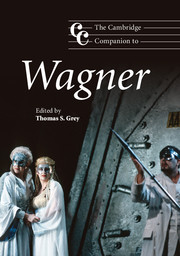Book contents
- Frontmatter
- PART I Biographical and historical contexts
- PART II Opera, music, drama
- 4 The “Romantic operas” and the turn to myth
- 5 Der Ring des Nibelungen: conception and interpretation
- 6 Leitmotif, temporality, and musical design in the Ring
- 7 Tristan und Isolde: essence and appearance
- 8 Performing Germany in Wagner's Die Meistersinger von Nürnberg
- 9 Parsifal: redemption and Kunstreligion
- PART III Ideas and ideology in the Gesamtkunstwerk
- PART IV After Wagner: influence and interpretation
- Notes
- Select bibliography
- Index
5 - Der Ring des Nibelungen: conception and interpretation
from PART II - Opera, music, drama
Published online by Cambridge University Press: 28 September 2011
- Frontmatter
- PART I Biographical and historical contexts
- PART II Opera, music, drama
- 4 The “Romantic operas” and the turn to myth
- 5 Der Ring des Nibelungen: conception and interpretation
- 6 Leitmotif, temporality, and musical design in the Ring
- 7 Tristan und Isolde: essence and appearance
- 8 Performing Germany in Wagner's Die Meistersinger von Nürnberg
- 9 Parsifal: redemption and Kunstreligion
- PART III Ideas and ideology in the Gesamtkunstwerk
- PART IV After Wagner: influence and interpretation
- Notes
- Select bibliography
- Index
Summary
The genesis of the Ring project
The outline of the drama that was to become Der Ring des Nibelungen, namely “Der Nibelungen-Mythus: Als Entwurf zu einem Drama,” dates from October 1848, the same year as the “Plan for the Organization of a German National Theater for the Kingdom of Saxony,” Wagner's radical proposal to establish an association of dramatists and composers along with a drama school and expanded court orchestra. That manifesto for theatrical reform naturally reflected Wagner's sociopolitical outlook of the period, hostile as it was to the status quo presided over by the aristocracy. The same preoccupation with nationhood and freedom also informed the contemporary reception of Greek drama, especially as mediated by the leading translator and commentator Johann Gustav Droysen.
The essays of the revolutionary period elaborate the emergent concept of the Wagnerian music drama in greater detail. Art and Revolution (1849) celebrates the Greek drama with its integration of all the arts, contrasting it with the vacuous, mercenary theater of the modern age. The Artwork of the Future (also 1849) develops this theme, proposing a Gesamtkunstwerk, or “total work of art,” that would unite dance, music, and poetry in a new kind of theater designed solely according to aesthetic and artistic criteria, no longer for commercial gain or social ostentation. And finally, Opera and Drama (1850–51), after offering a critique of the genres of modern opera and analyzing the nature and history of theater, attempts to illuminate the linguistic, dramatic, and musical ingredients of the proposed Gesamtkunstwerk.
- Type
- Chapter
- Information
- The Cambridge Companion to Wagner , pp. 74 - 84Publisher: Cambridge University PressPrint publication year: 2008

